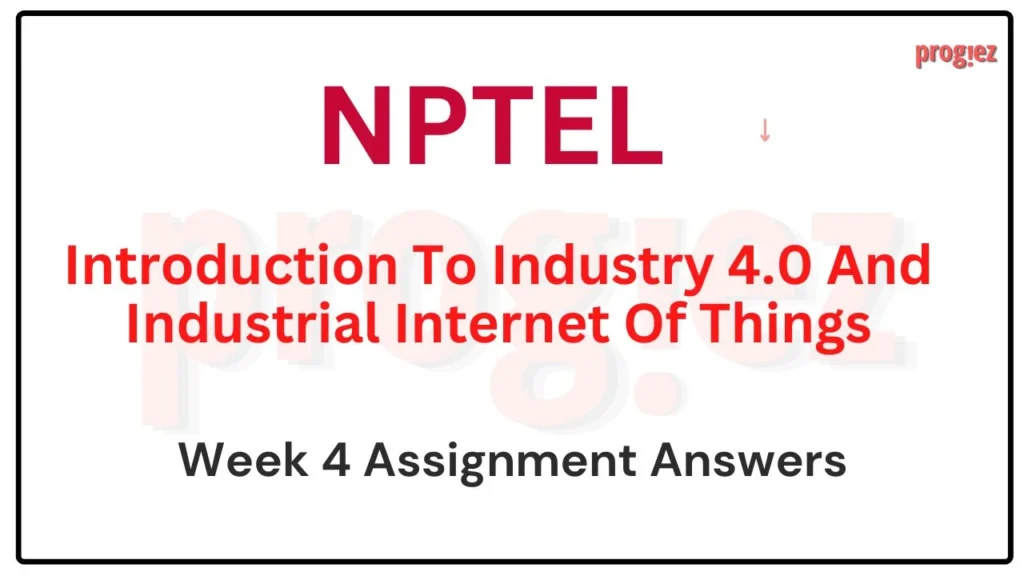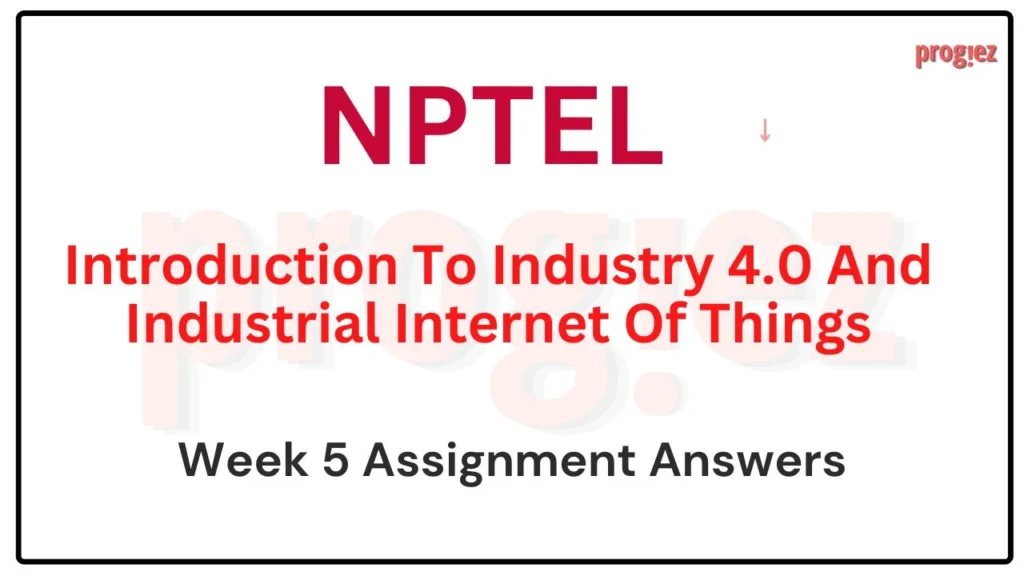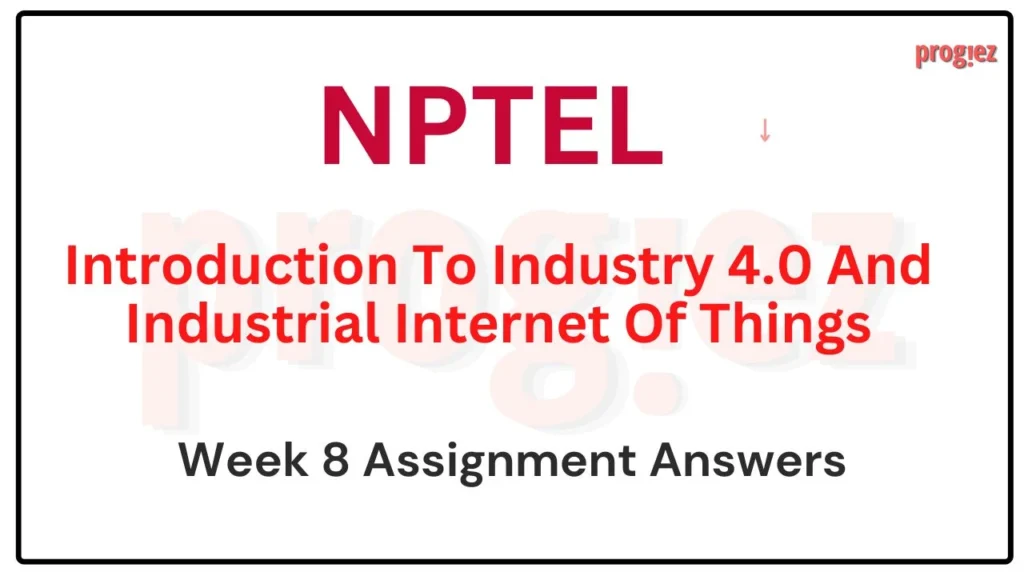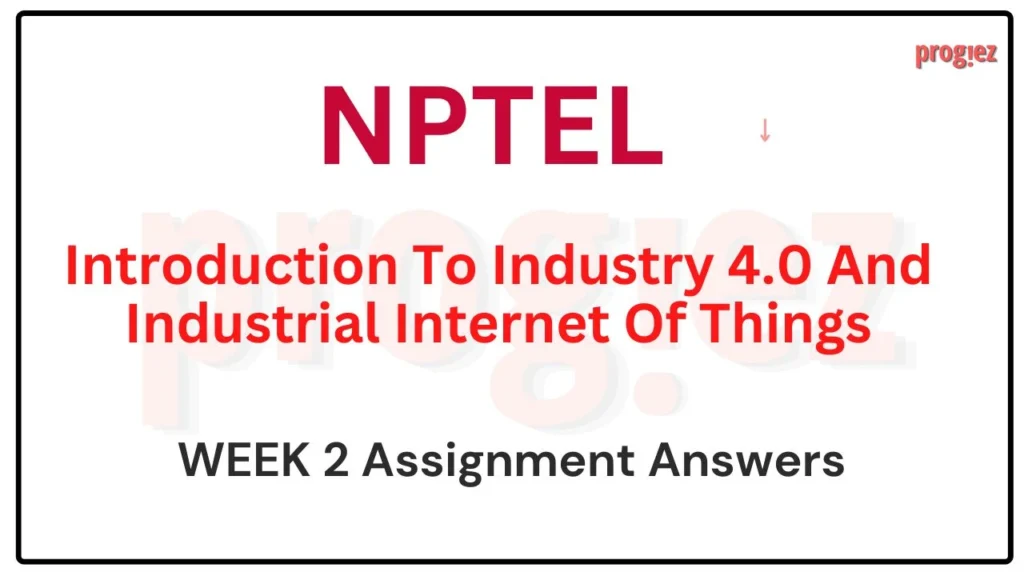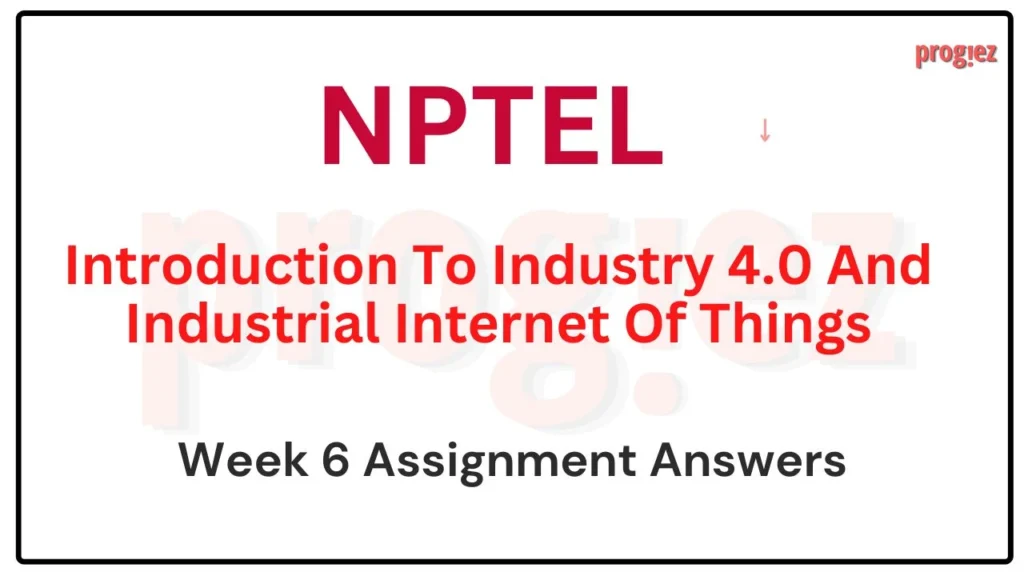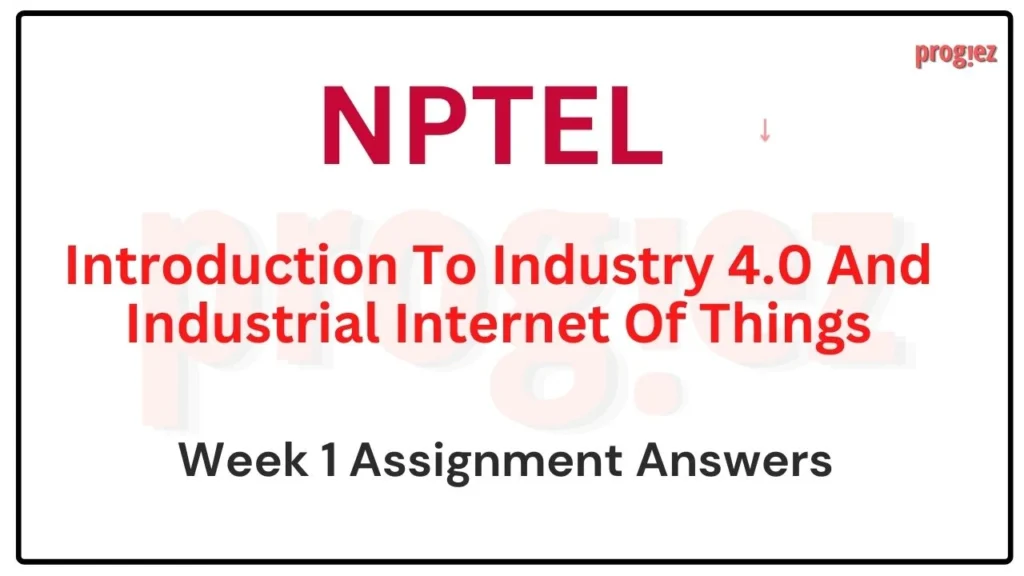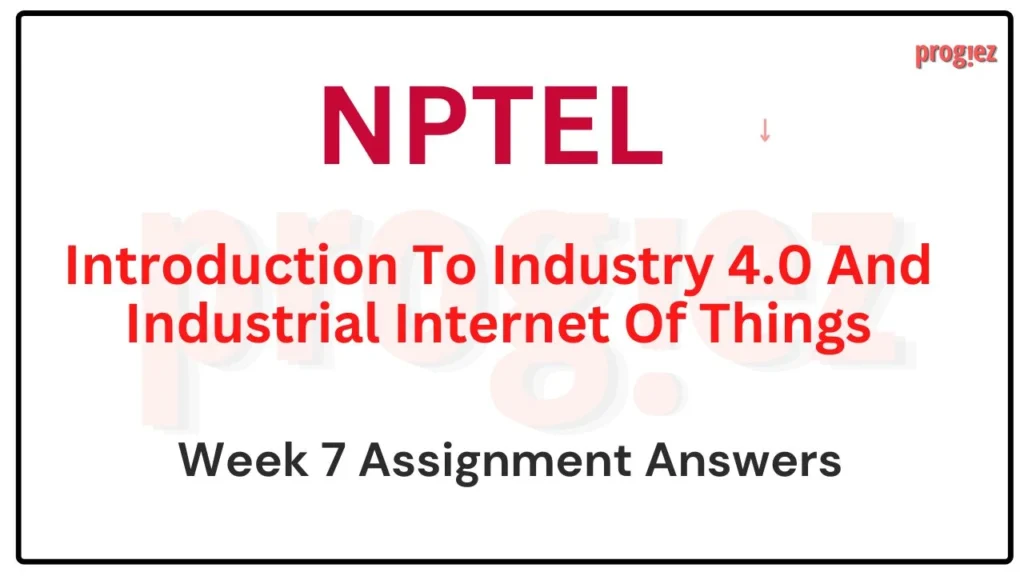Introduction to Industry 4 and Industrial IoT Week 3 Assignment Answers Nptel
Are you looking for the NPTEL Introduction to Industry 4 and Industrial IoT Week 3 Assignment Answers 2025 (Jan-Apr)? You’ve come to the right place!
Course Link: Click Here
Table of Contents
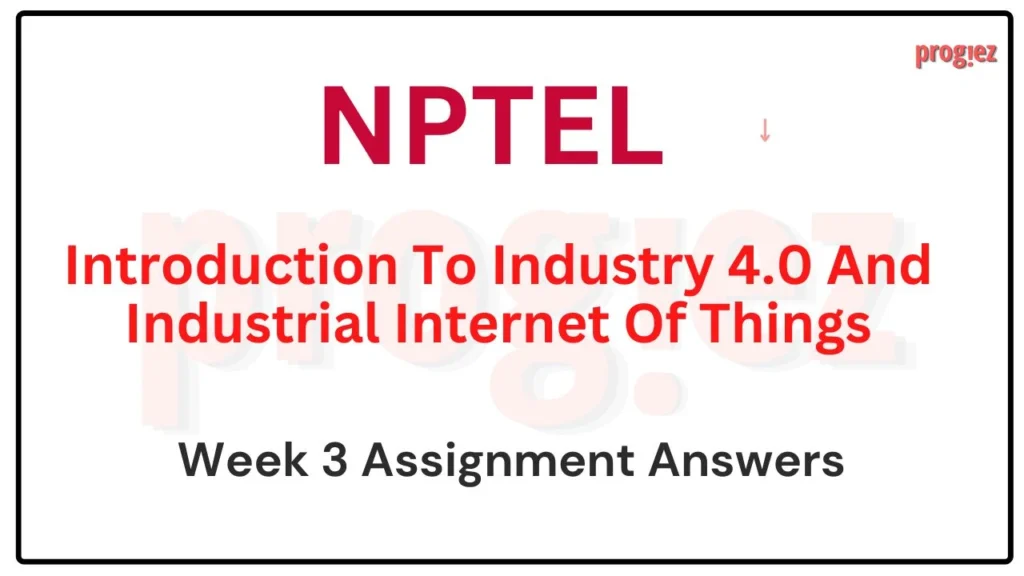
Introduction to Industry 4 and Industrial IoT Week 3 Assignment Answers (Jan-Apr 2025)
1) What is the main difference between Embedded Systems and Cyber-Physical Systems (CPS)?
a) Embedded systems are standalone devices, whereas CPS are networked systems.
b) CPS have limited resources, while embedded systems are not resource constrained.
c) Main issues of Embedded Systems are timing and concurrency, while the main issues of CPS are real-time response and reliability.
d) CPS lack physical components, while embedded systems include them.
2) What does “reactive computation” in CPS signify?
a) Systems with zero response time
b) Interaction with the environment in an ongoing manner
c) Predefined computation processes
d) Complete isolation from physical feedback
3) Fill in the blanks.
_In healthcare applications, CPS is used for _________.
a) Image-guided surgery and therapy
b) Manual monitoring of vitals
c) Static hospital management systems
d) Front desk management
4) Which programming language developed in 1958 aided the evolution of Artificial Intelligence?
a) Python
b) Lisp
c) Java
d) Prolog
5) Which level in the “5C Architecture” ensures the gathering of precise status information of machines?
a) Conversion
b) Cognition
c) Cyber
d) Configuration
6) Fill in the blanks.
_Intelligent sensors are capable of ____________.
a) Only sensing data
b) Processing sensed data and managing external sensors/devices
c) Limited communication
d) Basic analog-to-digital conversion
7) What are the five phases of the product lifecycle as per PLM in Industry 4.0?
a) Visualize, Explain, Perceive, Support, Retire
b) Research, Design, Marketing, Distribution, Recycling
c) Ideation, Manufacturing, Expansion, Customer Feedback, Upgradation
d) Requirement Analysis, Development, Testing, Deployment, Maintenance
8) How many steps are there in the PLM solution approach in Industry 4.0?
a) 8
b) 9
c) 10
d) 12
9) Which of the following is not a key component of an AR Device?
a) Sensors
b) Cameras
c) Projection Screen
d) Remote Control
10) Which of the following statements is incorrect?
a) Deep Learning is a subset of Machine Learning
b) Deep Learning is a subset of Artificial Intelligence
c) Machine Learning is a superset of Artificial Intelligence
d) Artificial Intelligence is a superset of Machine Learning
11) Which of the following is NOT a challenge of AI in IIoT?
a) Connecting devices
b) Understanding data
c) Training AI models
d) Lack of available data
12) What is the primary purpose of data preprocessing in Big Data analytics?
a) To store data without modification
b) To remove noises and redundancies before analysis
c) To generate fake data for testing purposes
d) To visualize trends before collection
13) What type of analytics is used to predict future trends based on historical data patterns?
a) Descriptive Analytics
b) Diagnostic Analytics
c) Predictive Analytics
d) Prescriptive Analytics
14) Which of the following is not one of the primary constraints of mobile CPS?
a) Stability of the network
b) Power requirement
c) Security
d) Design aesthetics
15) What are the components of the 5C architecture for CPS?
a) Connection, Conversion, Cyber, Cognition, Configuration
b) Creation, Controlling, Continuation, Convergence, Compatibility
c) Calculation, Catalysis, Convergence, Convenience, Cognizance
d) None of these
Introduction to Industry 4 and Industrial IoT Week 3 Assignment Answers (July-Dec 2024)
Q1.What are Cyber-Physical Systems (CPS)?
a. Systems that operate solely on physical components
b. Systems that operate only on computational components
c. Interacting networks of physical and computational components
d. Systems without any computational components
Answer: c. Interacting networks of physical and computational components
Q2. What is one of the key features of CPS in terms of computation?
a. Static computation
b. Reactive computation
c. Limited computation
d. Redundant computation
Answer: b. Reactive computation
For answers or latest updates join our telegram channel: Click here to join
These are NPTEL Introduction to Industry 4 and Industrial IoT Week 3 Assignment Answers
Q3.What architecture is used for designing CPS-based manufacturing systems for Industry 4.0?
a. 3C architecture
b. 5C architecture
c. 7C architecture
d. 9C architecture
Answer: b. 5C architecture
Q4.What is a collaboration platform in the context of Industry 4.0?
a. A type of business software that combines organizational networking capacities with operations
b. A social media platform for employees
c. A traditional project management tool
d. A financial management system
Answer: a. A type of business software that combines organizational networking capacities with operations
For answers or latest updates join our telegram channel: Click here to join
These are NPTEL Introduction to Industry 4 and Industrial IoT Week 3 Assignment Answers
Q5 .What does Single Source of Truth (SSoT) refer to in collaboration productivity?
a. Storing every data element exactly once
b. Storing multiple copies of each data element
c. Using outdated software for decision making
d. Storing the same data across different systems
Answer: a. Storing every data element exactly once
Q6.What is required for effective coordination in Industry 4.0 collaboration productivity?
a. Isolated decision-making
b. Centralized authority
c. Stronger coordination between multiple industry agents
d. Reducing the exchange of information
Answer: c. Stronger coordination between multiple industry agents
For answers or latest updates join our telegram channel: Click here to join
These are NPTEL Introduction to Industry 4 and Industrial IoT Week 3 Assignment Answers
Q7 .What is a key feature of Augmented Reality (AR)?
a. Completely replacing the physical environment
b. Enhancing the present perception of reality
c. Only providing auditory feedback
d. Operating in isolated systems
Answer: b. Enhancing the present perception of reality
Q8.What is a characteristic of Projection-based Augmented Reality?
a. Can provide location data without GPS
b. Projects light onto real-world surfaces
c. Uses only 4K displays for projection
d. Does not have acoustic element
Answer: b. Projects light onto real-world surfaces
For answers or latest updates join our telegram channel: Click here to join
These are NPTEL Introduction to Industry 4 and Industrial IoT Week 3 Assignment Answers
Q9.What does a fully immersive VR simulation provide?
a. No interaction with the virtual environment
b. A wide field of view with head-mounted displays and motion detecting devices
c. Only visual feedback without interaction with the user
d. Manual control over the real environment
Answer: b. A wide field of view with head-mounted displays and motion detecting devices
Q10.What type of AR uses visual markers for outcomes?
a. Marker-based Augmented Reality
b. Markerless Augmented Reality
c. Projection Based Augmented Reality
d. Superimposition Based Augmented Reality
Answer: a. Marker-based Augmented Reality
For answers or latest updates join our telegram channel: Click here to join
These are NPTEL Introduction to Industry 4 and Industrial IoT Week 3 Assignment Answers
Q11.Who proposed the first use of the phrase “Artificial Intelligence”?
a. Alan Turing
b. John McCarthy
c. Marvin Minsky
d. Herbert Simon
Answer: b. John McCarthy
Q12.Which of the following statements is true?
a. A program without Al uses a large knowledge base and heuristic search method
b. A program with Al uses a large database and algorithmic search method
c. A program with Al uses a large knowledge base and heuristic search method
d. A program without Al uses a large database and heuristic search method
Answer: c. A program with Al uses a large knowledge base and heuristic search method
For answers or latest updates join our telegram channel: Click here to join
These are NPTEL Introduction to Industry 4 and Industrial IoT Week 3 Assignment Answers
Q13. According to NIST, what restricts the capacity of using conventional methods to manage Big Data?
a. Data quality
b. Acquisition speed, data volume, or data characterization
c. Data accessibility
d. Data format
Answer: b. Acquisition speed, data volume, or data characterization
Q14. What does the velocity characteristic of Big Data refer to?
a. The category of the data
b. The speed of generation of data
c. The quality of the data
d. The volume of the data
Answer: b. The speed of generation of data
For answers or latest updates join our telegram channel: Click here to join
These are NPTEL Introduction to Industry 4 and Industrial IoT Week 3 Assignment Answers
Q15.Which of the following are constraints of mobile CPS?
a. Network stability
b. Power requirement
c. Security
d. All of the above
Answer: d. All of the above
For answers or latest updates join our telegram channel: Click here to join
These are NPTEL Introduction to Industry 4 and Industrial IoT Week 3 Assignment Answers
All weeks of Introduction To Industry 4.0 And Industrial Internet Of Things: Click Here
For answers to additional Nptel courses, please refer to this link: NPTEL Assignment Answers
Introduction to Industry 4 and Industrial IoT Week 3 Assignment Answers (Jan-Apr 2024)
Course Name: Introduction To Industry 4.0 And Industrial Internet Of Things
Course Link: Click Here
For answers or latest updates join our telegram channel: Click here to join
These are NPTEL Introduction to Industry 4 Assignment 3 Answers And Industrial Internet Of Things
Q1. Which of the following is not a feature of Cyber-Physical Systems?
a. Reactive Computation
b. Concurrency
c. Real-Time Computation
d. Standalone non-networked Computation
Answer: d. Standalone non-networked Computation
Q2. In the context of CPS in Smart Grid, what is the full form of DAU?
a. Data Aggregation Unit
b. Data Analytic Unit
c. Distributed Augmented Universe
d. Dedicated Accounting Unit
Answer: a. Data Aggregation Unit
Q3. Which of the following is not a component of CPS’s “5C Architecture” for Industry 4.0?
a. Connection
b. Conversion
c. Compatibility
d. Cognition
Answer: c. Compatibility
For answers or latest updates join our telegram channel: Click here to join
These are NPTEL Introduction to Industry 4 and Industrial IoT Week 3 Assignment Answers
Q4. What are the key parts enabling collaboration productivity in Industry 4.0?
a. IT Proliferation, Single Source of Truth, Industrialization, Coordination
b. Financial Analysis, Market Research, Legal Compliance, Public Relations
c. Human Resources, Sales Targets, Customer Feedback, Advertising
d. Supply Chain Management, Quality Control, Cost Reduction, Branding
Answer: a. IT Proliferation, Single Source of Truth, Industrialization, Coordination
Q5. What does ‘PLM’ stand for in the context of Industry 4.0?
a. Product Lifecycle Management
b. Public Liability Marketing
c. Professional Learning Modules
d. Personal Leadership Mastery
Answer: a. Product Lifecycle Management
Q6. What does the Technique ‘ABC’ in PLM stand for?
a. Activity Based Costing
b. Advanced Business Computing
c. Analytical Business Concepts
d. Automated Banking Coordination
Answer: a. Activity Based Costing
For answers or latest updates join our telegram channel: Click here to join
These are NPTEL Introduction to Industry 4 and Industrial IoT Week 3 Assignment Answers
Q7. In which fields are AR and VR used in Industry 4.0?
a. Cooking and nutrition
b. Fashion design only
c. Machining, production, and education
d. Network Security
Answer: c. Machining, production, and education
Q8. Which among the following is one type of categorization of AR?
a. Marker-attached AR
b. Markerless AR
c. Null AR
d. Marker-like AR
Answer: b. Markerless AR
Q9. Which among the following is one type of categorization of AR?
a. Marker-attached AR
b. Markerless AR
c. Null AR
d. Marker-like AR
Answer: a. Marker-attached AR
For answers or latest updates join our telegram channel: Click here to join
These are NPTEL Introduction to Industry 4 and Industrial IoT Week 3 Assignment Answers
Q10. What type of AR uses visual markers for outcomes?
a. Marker-based Augmented Reality
b. Markerless Augmented Reality
c. Projection Based Augmented Reality
d. Superimposition Based Augmented Reality
Answer: a. Marker-based Augmented Reality
Q11. What type of knowledge is used in Al techniques?
a. Only historical data
b. Only factual information
c. Procedural, declarative, and heuristic knowledge
d. Limited to scientific formulas
Answer: c. Procedural, declarative, and heuristic knowledge
Q12. What is the use of Al in IloT?
a. No use in IIoT
b. Only for data storage
c. Machine safety, efficient product lifecycle, efficient manufacturing processes, and others
d. Limited to basic calculations
Answer: c. Machine safety, efficient product lifecycle, efficient manufacturing processes, and others
For answers or latest updates join our telegram channel: Click here to join
These are NPTEL Introduction to Industry 4 and Industrial IoT Week 3 Assignment Answers
Q13. Which of the following characterizes Big Data?
a. Limited to textual data only
b. Consists of structured and non-structured data
c. Only includes numerical data
d. Data that is always organized
Answer: b. Consists of structured and non-structured data
Q14. What does a distributed file system in Big Data ensure?
a. Inconsistency of data
b. Unreliable data storage
c. Consistency, accessibility, and fault tolerance of data
d. Limited data access
Answer: c. Consistency, accessibility, and fault tolerance of data
Q15. Suppose you write a program which uses an API to collect data continuously from LinkedIn and Facebook. You then wish to analyze such data. What type of big data source are you using?
a. Internal data source
b. External data source
c. Complimentary data source
d. All of the above
Answer: b. External data source
For answers or latest updates join our telegram channel: Click here to join
These are NPTEL Introduction to Industry 4 and Industrial IoT Week 3 Assignment Answers
More Solutions of Introduction To Industry 4.0 And Industrial Internet Of Things: Click Here
More Nptel Courses: Click here
Introduction to Industry 4 and Industrial IoT Week 3 Assignment Answers (Jan-Apr 2023)
Course Name: Introduction To Industry 4.0 And Industrial Internet Of Things
Course Link: Click Here
These are NPTEL Introduction to Industry 4 Assignment 3 Answers And Industrial Internet Of Things
Q1. Which of the following is true regarding Cyber-Physical Systems?
(a) They are devices having information processing systems embedded into them.
(b) They are typically confined to a single device
(c) They are networked set of embedded systems
(d) All of the above
Answer: (c) They are networked set of embedded systems
Q2. What are the 5 Cs in the CPS “5C architecture” for Industry 4.0?
(a) Connection, Conversion, Cyber, Cognition, Configuration
(b) Connection, Communication, Cyber, Cognition, Configuration
(c) Connection, Communication, Cyber, Carrier, Configuration
(d) Connection, Conversion, Cyber, Cognition, Carrier
Answer: (a) Connection, Conversion, Cyber, Cognition, Configuration
Q3. What are Smart Sensors?
(a) They are the integration of sensors and actuators with a processor and a communication module.
(b) They are universal sensors which can sense a wide range of different stimuli.
(c) They are the kind of sensors which do not require a power source to operate.
(d) All of the above
Answer: (a) They are the integration of sensors and actuators with a processor and a communication module.
These are NPTEL Introduction to Industry 4 and Industrial IoT Week 3 Assignment Answers
Q4. Which of the following is an example of Collaboration platform
(a) Google Drive
(b) Outlook
(c) Backblaze
(d) ProWork Flow
Answer: (d) ProWork Flow
Q5. State true or false — “PLM handles a product completely, from single part of the product to entire portfolio of that product”.
(a) True
(b) False
Answer:(a) True
Q6. In PLM, how many phases does a product lifecycle have?
(a) 3
(b) 4
(c) 5
(d) 6
Answer: (c) 5
These are NPTEL Introduction to Industry 4 and Industrial IoT Week 3 Assignment Answers
Q7. ________ is direct/indirect views of physical world environments which are “augmented” with computer-generated superimposed images
(a) Augmented Reality
(b) Virtual Reality
(c) Both (a) and (b)
(d) Neither (a) nor (b)
Answer: (a) Augmented Reality
Q8. What are the four different types of Augmented Reality?
(a) Marker-Based, Markerless, Fully-immersive, Semi-immersive
(b) Marker-Based, Markerless, Non-immersive, Superimposition Based
(c) Marker-Based, Non-immersive, Fully-immersive, Semi-immersive
(d) Marker-Based, Markerless, Projection Based, Superimposition Based
Answer: (d) Marker-Based, Markerless, Projection Based, Superimposition Based
Q9. __ augmented reality is commonly utilized for mapping directions.
(a) Marker-based
(b) Markerless
(c) Projection Based
(d) Superimposition Based
Answer: (b) Markerless
These are NPTEL Introduction to Industry 4 and Industrial IoT Week 3 Assignment Answers
Q10. Which VR type uses head-mounted displays and motion-detecting devices to simulate user’s experiences?
(a) Fully-immersive simulations
(b) Semi-immersive simulations
(c) Non-immersive simulations
(d) Both (a) and (b)
Answer: (a) Fully-immersive simulations
Q11. State true or false — “Linear regression, logistic regression, random forest, decision tree are some of the most popular unsupervised learning algorithms”.
(a) False
(b) True
Answer: (a) False
Q12. A computer program without AI uses __ method whereas computer program with AI uses _ method
(a) Large database and algorithmic search, Large knowledge base and heuristic search
(b) Large knowledge base and heuristic search, Large database and algorithmic search
(c) Large knowledge base and algorithmic search, Large database and heuristic search
(d) None of the above
Answer: (a) Large database and algorithmic search, Large knowledge base and heuristic search
These are NPTEL Introduction to Industry 4 and Industrial IoT Week 3 Assignment Answers
Q13. Which of the following is correct?
(a) Machine Learning ⊆ Deep Learning ⊆ Artificial Intelligence
(b) Deep Learning ⊆ Artificial Intelligence ⊆ Machine Learning
(c) Deep Learning ⊆ Machine Learning ⊆ Artificial Intelligence
(d) Artificial Intelligence ⊆ Machine Learning ⊆ Deep Learning
Answer: (c) Deep Learning ⊆ Machine Learning ⊆ Artificial Intelligence
Q14. Big data consists of __.
(a) Both structured and non-structured data
(b) Only structured data
(c) Only non-structured data
(d) None of the above
Answer: (a) Both structured and non-structured data
Q15. What does the word “veracity” indicate in Big Data?
(a) It indicates the data which have no restriction over the input data formats.
(b) It indicates velocity of generation of data.
(c) It indicates the data whose meaning is constantly changing.
(d) It indicates biasness in the data, unusualness and noise in data.
Answer: (d) It indicates biasness in the data, unusualness and noise in data.
These are NPTEL Introduction to Industry 4 and Industrial IoT Week 3 Assignment Answers
More weeks of Introduction To Industry 4.0 And Industrial Internet Of Things: Click Here
More Nptel Courses: https://progiez.com/nptel
Introduction to Industry 4 and Industrial IoT Week 3 Assignment Answers (Jul-Dec 2022)
Course Name: Introduction to industry 4.0 and Industrial Internet of Things
Course Link: Click Here
These are NPTEL Introduction to Industry 4 and Industrial IoT Week 3 Assignment Answers
Q1. What is the difference between a Cyber-Physical System (CPS) and an embedded system?
a. CPS is confined to one system, while embedded system is a networked set of multiple CPSS
b. Embedded system is confined to one system, while CPS is a networked set of multiple embedded systems
c. Both a and b
d. None of the above
Answer: b. Embedded system is confined to one system, while CPS is a networked set of multiple embedded systems
Q2. “Cyber-Physical systems are equipped with control systems with feedback loop”. Is the statement true or false?
a. True
b. False
Answer: a. True
Q3. What is cognition in CPS architecture for lloT?
a. Conversion of machine data to meaningful information
b. Supervisory control to determine actions to be taken by the machines
c. Both a and b
d. Proper presentation of information to users for generating thorough knowledge of the system
Answer: d. Proper presentation of information to users for generating thorough knowledge of the system
These are NPTEL Introduction to Industry 4 and Industrial IoT Week 3 Assignment Answers
Q4. “Sensors with small memory and standardized physical connection to enable the communication with processor and data network”. Select the option which refers to this statement.
a. Smart sensor
b. DHT sensor
c. LED sensor
d. ESP32
Answer: a. Smart sensor
Q5. What are the advantages of intelligent sensors?
a. Reduce data communication
b. Application-specific customization of sensor nodes
c. Continuous calibrating and monitoring of the sensors
d. All of the above
Answer: d. All of the above
These are NPTEL Introduction to Industry 4 and Industrial IoT Week 3 Assignment Answers
Q6. Which of the following statements is/are true about Collaboration platform?
a. Category of business software which combines organizational networking capacities to operations.
b. It does not include knowledge management into business operation to encourage
c. Collaboration platform restricts employees to share information
d. All of the above
Answer: a. Category of business software which combines organizational networking capacities to operations.
These are NPTEL Introduction to Industry 4 and Industrial IoT Week 3 Assignment Answers
Q7. How many key parts are there which enable collaborative productivity in Industry 4.0?
a. 5
b. 4
c. 7
d. 9
Answer: b. 4
Q8. In context of Industry 4.0, what does PLM stand for?
a. Product Life Management
b. Product Lifecycle Management
c. Both (a) and (b)
d. None of the above
Answer: b. Product Lifecycle Management
These are NPTEL Introduction to Industry 4 and Industrial IoT Week 3 Assignment Answers
Q9. How many phases are there in a product lifecycle?
a. 6
b. 9
c. 5
d. 3
Answer: c. 5
These are NPTEL Introduction to Industry 4 and Industrial IoT Week 3 Assignment Answers
Q10. Which of the following is/are features of smart factory?
a. Connected Environment
b. Transparency of process status
c. Both a and b
d. None of the above
Answer: c. Both a and b
These are NPTEL Introduction to Industry 4 and Industrial IoT Week 3 Assignment Answers
Q11. Which of the following is not a type of augmented reality?
a. Marker-based AR
b. Markerless AR
c. Superimposition-based AR
d. Timer-based AR
Answer: d. Timer-based AR
These are NPTEL Introduction to Industry 4 and Industrial IoT Week 3 Assignment Answers
Q12. “Semi-immersive simulations provide a partial or fully immersive experience of the user’s senses.” True or False?
a. True
b. False
Answer: b. False
These are NPTEL Introduction to Industry 4 and Industrial IoT Week 3 Assignment Answers
Q13. “Machine learning is a subset of deep learning which can learn automatically by finding the features of the object by own.” True or False?
a. True
b. False
Answer: b. False
These are NPTEL Introduction to Industry 4 and Industrial IoT Week 3 Assignment Answers
Q14. What is velocity in Big Data?
a. Speed of generation of data
b. Categories of data
c. Data with constantly changing meaning
d. All of the above
Answer: a. Speed of generation of data
These are NPTEL Introduction to Industry 4 and Industrial IoT Week 3 Assignment Answers
Q15. Select the types of analytics for big data?
a. Descriptive
b. Prescriptive
c. Predictive
d. All of the above
Answer: d. All of the above
These are NPTEL Introduction to Industry 4 and Industrial IoT Week 3 Assignment Answers
